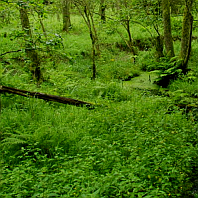The coincidence this week of a national holiday and sunny weather allowed us to address a lot of pending work.
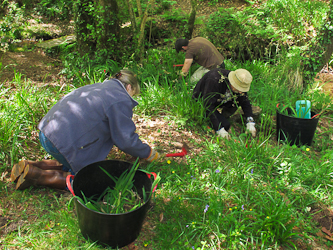 On Monday a volunteer got to the Sobrado Lake to do the regular tasks of cleaning and maintenance of the bird hide, and to remove litter from the two plots in which we do land stewardship, the banks of the lagoon and the stretch of the Way of Saint James that goes alongside it.
On Monday a volunteer got to the Sobrado Lake to do the regular tasks of cleaning and maintenance of the bird hide, and to remove litter from the two plots in which we do land stewardship, the banks of the lagoon and the stretch of the Way of Saint James that goes alongside it.
On Thursday morning four volunteers got to the spot of Chelo (Coirós) to continue the montbretia campaign. They spent four hours squatted to uproot the tubers. They didn’t remove so many, since we have almost eradicated it from the banks of the River Mandeo between the Chelo footbridge and the Teixeiro Bridge, where we have already removed more than 172,000 tubers. But their work has been really important to prevent the montbretia (Crocosmia x crocosmiiflora) to recover from a few remaining tubers.
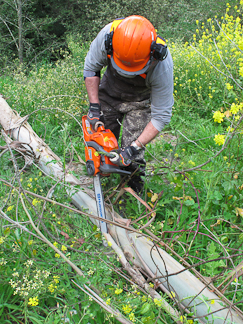 In the afternoon, three volunteers went to the Ollo da Roda reserve, by the River Mendo. They prepared an area to be planted with native trees, by cutting eucalyptus and piling up the foliage.
In the afternoon, three volunteers went to the Ollo da Roda reserve, by the River Mendo. They prepared an area to be planted with native trees, by cutting eucalyptus and piling up the foliage.
The water level at Do Catorce reserve is very low because of dry weather and high temperatures. Amphibians are suffering, since some ponds are getting waterless at a time when tadpoles haven’t metamorphosed yet. We tried to relieve this by taking 340 litres of water, but it wasn’t enough because of evaporation. Finally, we opted for moving those that were stuck on the drying mud to ponds with more water.
On Saturday other three volunteers went over to A Espenuca. The path that crosses the wood plot on the northern slope, in which we do land stewardship, was getting closed in by gorses and brackens, so it needed bush clearance. We went over the eucalyptus elimination too: only a few new shoots appeared, but many other sprouts from seeds. Little by little the native wood is recovering.
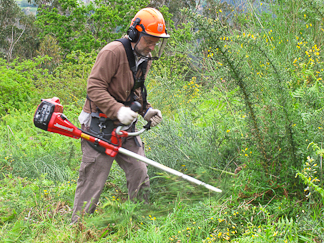 On Sunday a volunteer did a cleaning route along the banks of the River Mandeo, from the spot of Chelo to Cal dos Arados. We regularly remove litter along the downstream route from Chelo to the Teixeiro Bridge, because it is the most frequented. But more and more hikers walk along the upstream route, so there is always some litter. Additionally, he recorded the spots where he found exotic species: small-leaf spiderwort (Tradescantia fluminensis), cherry laurel (Prunus laurocerasus) and calla lily (Zantedeschia aethiopica). They shall be eliminated as soon as possible.
On Sunday a volunteer did a cleaning route along the banks of the River Mandeo, from the spot of Chelo to Cal dos Arados. We regularly remove litter along the downstream route from Chelo to the Teixeiro Bridge, because it is the most frequented. But more and more hikers walk along the upstream route, so there is always some litter. Additionally, he recorded the spots where he found exotic species: small-leaf spiderwort (Tradescantia fluminensis), cherry laurel (Prunus laurocerasus) and calla lily (Zantedeschia aethiopica). They shall be eliminated as soon as possible.
In short: a busy week during which people engaged with biodiversity conservation in our area devoted their leisure time to a really effective environmental volunteering.
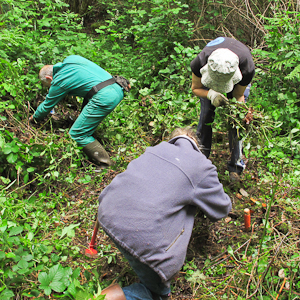 Fragas do Mandeo has been working on the eradication of invasive exotic species by the River Mandeo since 2014. On the stretch between the Chelo footbridge and the Teixeiro Bridge, besides the above mentioned species, they have eliminated the garden privet (Ligustrum ovalifolium), the blackwood acacia (Acacia melanoxylon), the Pampas grass (Cortaderia selloana), the tall flatsedge (Cyperus eragrostis), the buddleia (Buddleja davidii) and the hydrangea (Hydrangea sp.).
Fragas do Mandeo has been working on the eradication of invasive exotic species by the River Mandeo since 2014. On the stretch between the Chelo footbridge and the Teixeiro Bridge, besides the above mentioned species, they have eliminated the garden privet (Ligustrum ovalifolium), the blackwood acacia (Acacia melanoxylon), the Pampas grass (Cortaderia selloana), the tall flatsedge (Cyperus eragrostis), the buddleia (Buddleja davidii) and the hydrangea (Hydrangea sp.).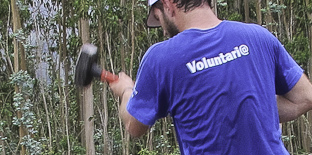 Between August 1st and 12th, fifteen volunteers are going to collaborate with us in the elimination of invasive exotic species in the surroundings of the River Mandeo. As a result of
Between August 1st and 12th, fifteen volunteers are going to collaborate with us in the elimination of invasive exotic species in the surroundings of the River Mandeo. As a result of 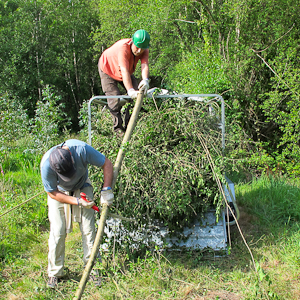 Last Saturday a couple of volunteers went to remove litter along the coastal stretch between the A Ribeira and Alameda beaches (Miño), within the protected natural area SAC Betanzos-Mandeo. They filled two sacks of debris and removed several ropes of bateas (mussel culture rafts). They also checked if any
Last Saturday a couple of volunteers went to remove litter along the coastal stretch between the A Ribeira and Alameda beaches (Miño), within the protected natural area SAC Betanzos-Mandeo. They filled two sacks of debris and removed several ropes of bateas (mussel culture rafts). They also checked if any  On Monday a volunteer got to the Sobrado Lake to do the regular tasks of cleaning and maintenance of the bird hide, and to remove litter from the two plots in which we do land stewardship, the banks of the lagoon and the stretch of the Way of Saint James that goes alongside it.
On Monday a volunteer got to the Sobrado Lake to do the regular tasks of cleaning and maintenance of the bird hide, and to remove litter from the two plots in which we do land stewardship, the banks of the lagoon and the stretch of the Way of Saint James that goes alongside it.  In the afternoon, three volunteers went to the Ollo da Roda reserve, by the River Mendo. They prepared an area to be planted with native trees, by cutting eucalyptus and piling up the foliage.
In the afternoon, three volunteers went to the Ollo da Roda reserve, by the River Mendo. They prepared an area to be planted with native trees, by cutting eucalyptus and piling up the foliage. On Sunday a volunteer did a cleaning route along the banks of the River Mandeo, from the spot of Chelo to Cal dos Arados. We regularly remove litter along the downstream route from Chelo to the Teixeiro Bridge, because it is the most frequented. But more and more hikers walk along the upstream route, so there is always some litter. Additionally, he recorded the spots where he found exotic species:
On Sunday a volunteer did a cleaning route along the banks of the River Mandeo, from the spot of Chelo to Cal dos Arados. We regularly remove litter along the downstream route from Chelo to the Teixeiro Bridge, because it is the most frequented. But more and more hikers walk along the upstream route, so there is always some litter. Additionally, he recorded the spots where he found exotic species:  The income tax declaration exercise has started today, ending on June 30. All of us have the duty to pay our part. But there are legal ways to pay less and in so doing, support nature conservation.
The income tax declaration exercise has started today, ending on June 30. All of us have the duty to pay our part. But there are legal ways to pay less and in so doing, support nature conservation.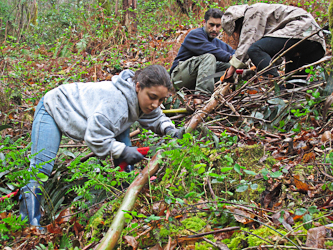 A deciduous wood, still young, is growing on this plot. The aim of the volunteering day was to eliminate all the low eucalyptus trees that are growing in the middle of native trees, so that the young trees do not have to compete with them and the ecosystem recovers totally.
A deciduous wood, still young, is growing on this plot. The aim of the volunteering day was to eliminate all the low eucalyptus trees that are growing in the middle of native trees, so that the young trees do not have to compete with them and the ecosystem recovers totally.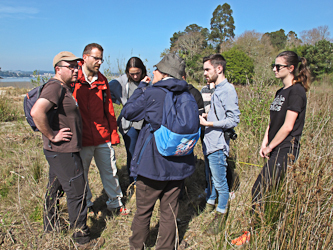 Today we have accompanied a group of Biology students of the University of A Coruña and two of their teachers to visit the Alameda Beach (Miño). The aim was for the students to start the practice of Botany following the service-learning method, within the agreement signed by Fragas do Mandeo and the University.
Today we have accompanied a group of Biology students of the University of A Coruña and two of their teachers to visit the Alameda Beach (Miño). The aim was for the students to start the practice of Botany following the service-learning method, within the agreement signed by Fragas do Mandeo and the University. 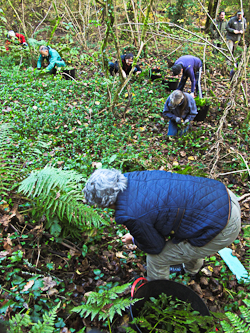 The strength of this invasive exotic plant is its fragility. When uprooted, it easily breaks, which makes difficult its removal. Moreover, any small piece left can take root and recolonize the area. So, you have to be very methodical in its elimination and constant in the subsequent supervision of the area.
The strength of this invasive exotic plant is its fragility. When uprooted, it easily breaks, which makes difficult its removal. Moreover, any small piece left can take root and recolonize the area. So, you have to be very methodical in its elimination and constant in the subsequent supervision of the area.
